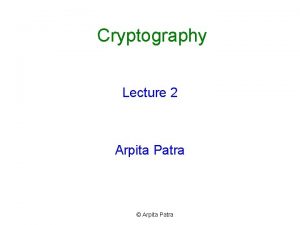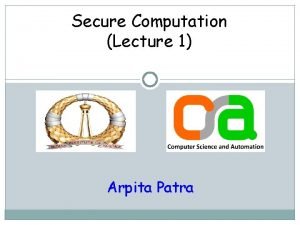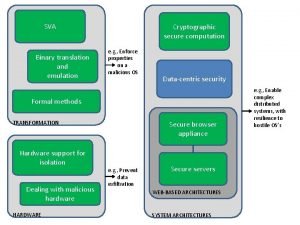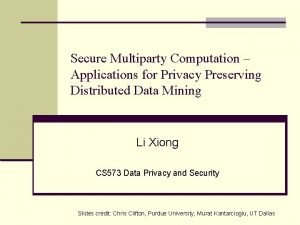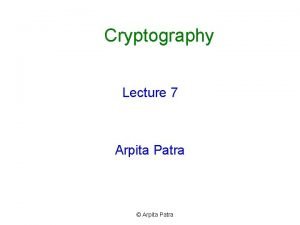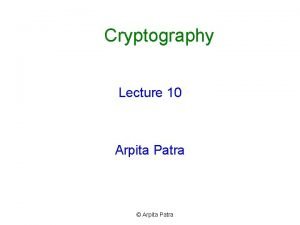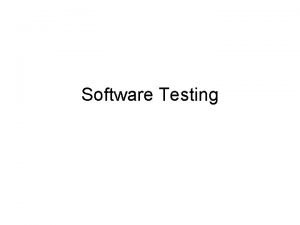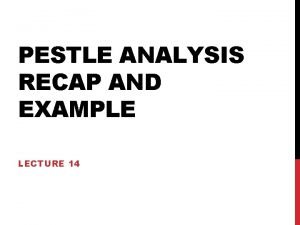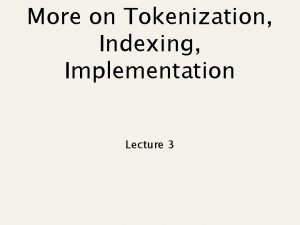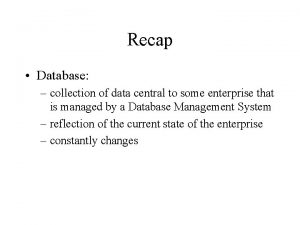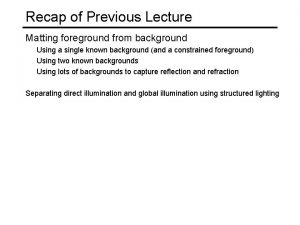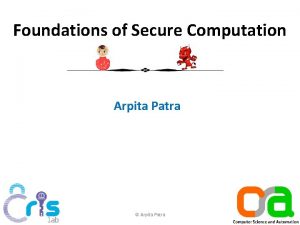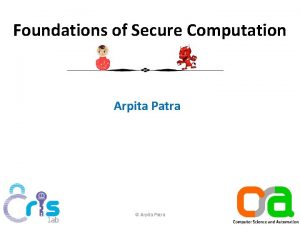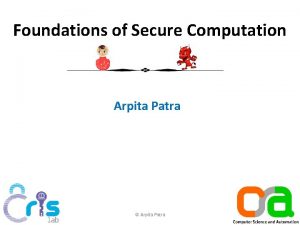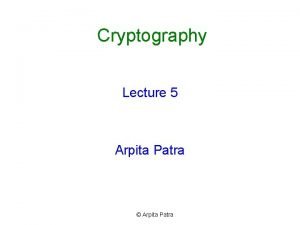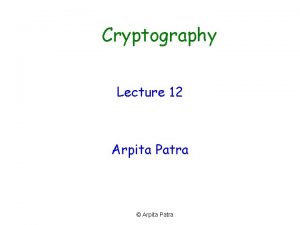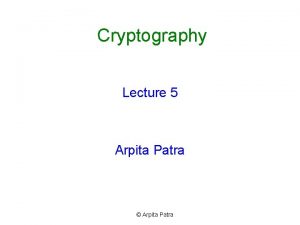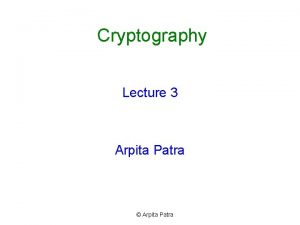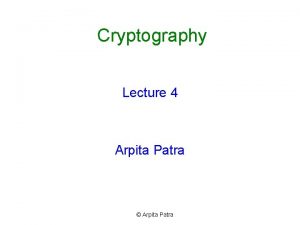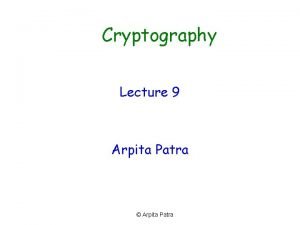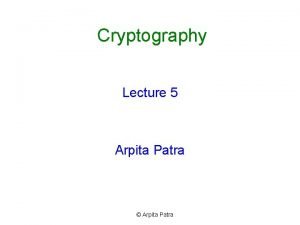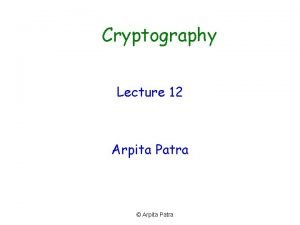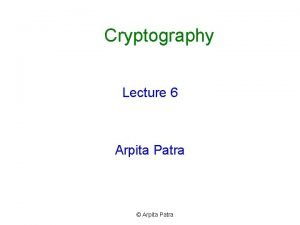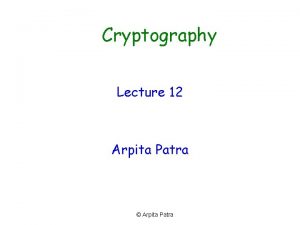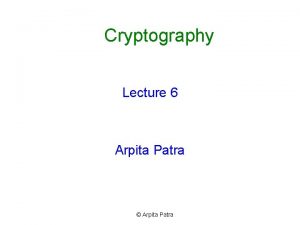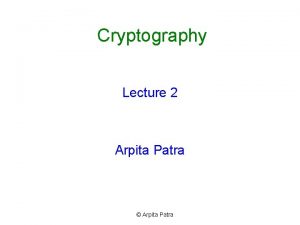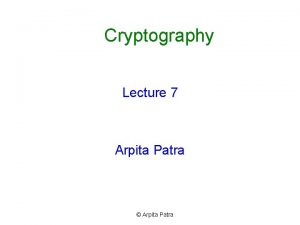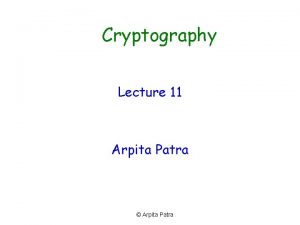Secure Computation Lecture 17 18 Arpita Patra Recap


![i. t Multi-party Computation [BGW] 1 2 5 3 9 45 48 144 1. i. t Multi-party Computation [BGW] 1 2 5 3 9 45 48 144 1.](https://slidetodoc.com/presentation_image_h/077612c7d3766c7a97a94d6580c1d68a/image-3.jpg)
![Definition of VSS [CGMA 85] Extends Secret Sharing to the case of malicious corruption Definition of VSS [CGMA 85] Extends Secret Sharing to the case of malicious corruption](https://slidetodoc.com/presentation_image_h/077612c7d3766c7a97a94d6580c1d68a/image-4.jpg)
![Definition of VSS [CGMA 85] Continued. . q n parties P = {P 1, Definition of VSS [CGMA 85] Continued. . q n parties P = {P 1,](https://slidetodoc.com/presentation_image_h/077612c7d3766c7a97a94d6580c1d68a/image-5.jpg)





















![Chalk & Talks CT 4 [LR 15]: Blazing Fast 2 PC in the Offline/Online Chalk & Talks CT 4 [LR 15]: Blazing Fast 2 PC in the Offline/Online](https://slidetodoc.com/presentation_image_h/077612c7d3766c7a97a94d6580c1d68a/image-27.jpg)

- Slides: 28

Secure Computation Lecture 17 -18 Arpita Patra

Recap >> i. t (perfect) MPC in malicious Setting >Three orthogonal problems- (n, t)-sharing, reconstruction, multiplication protocol > Verifiable Secret Sharing (VSS) will take care first two problems >> Verifiable Secret Sharing (VSS) > Definition (Secrecy, Correctness, Strong Commitment) > Properties of Bivariate polynomial > Six round construction based on bivariate poly with n > 3 t > Four round construction with minor tweaks > Reconstruction from error correction of RS codes- will be discussed today
![i t Multiparty Computation BGW 1 2 5 3 9 45 48 144 1 i. t Multi-party Computation [BGW] 1 2 5 3 9 45 48 144 1.](https://slidetodoc.com/presentation_image_h/077612c7d3766c7a97a94d6580c1d68a/image-3.jpg)
i. t Multi-party Computation [BGW] 1 2 5 3 9 45 48 144 1. 3 (n, t)- secret share each input 2. Find (n, t)-sharing of each intermediate value Linear gates: Linearity of Shamir Sharing - Non-Interactive Non-linear gate: Require degreereduction Technique. Interactive 3. Reconstruct the Shamir-sharing of the output by exchanging shares with each other
![Definition of VSS CGMA 85 Extends Secret Sharing to the case of malicious corruption Definition of VSS [CGMA 85] Extends Secret Sharing to the case of malicious corruption](https://slidetodoc.com/presentation_image_h/077612c7d3766c7a97a94d6580c1d68a/image-4.jpg)
Definition of VSS [CGMA 85] Extends Secret Sharing to the case of malicious corruption Secret s Dealer s is committed secure Sharing Phase v 1 v 2 v 3 … vn Reconstruction Phase Secret s
![Definition of VSS CGMA 85 Continued q n parties P P 1 Definition of VSS [CGMA 85] Continued. . q n parties P = {P 1,](https://slidetodoc.com/presentation_image_h/077612c7d3766c7a97a94d6580c1d68a/image-5.jpg)
Definition of VSS [CGMA 85] Continued. . q n parties P = {P 1, …, Pn}, dealer D (e. g. , D = P 1) q t corrupted parties (possibly including D) At Secrecy – If D is honest, then At has no information about secret s during the Sharing phase Correctness – If D is honest, then secret s will be correctly reconstructed during reconstruction phase Strong Commitment – Corrupted D commits a unique s* - s* should be uniquely reconstructed

Bivariate Polynomial and its properties F(x, y) of degree atmost (t, t) f 1(x) = F(x, 1) fi(x) = F(x, i) fn(x) = F(x, n) g 1(y) = F(1, y) F(1, 1) F(1, 2) . F(1, i) g 2(y) = F(2, y) F(2, 1) F(2, 2) . F(2, i) . . . F(i, 1) F(i, 2) . F(i, i) . F(i, n) . . . F(n, 1) F(n, 2) gi(y) = F(i, y) gn(y) = F(n, y) F(n, i) Claim 1: t F(x, i)’s and t F(i, y)’s will leak NO info about F(0, 0). Claim 2: (t+1) F(x, i)’s or (t+1) F(i, y)’s completely determine F(x, y). Claim 3: gi(j) = fj(i) = F(i, j) and gj(i) = fi(j) = F(j, i) . F(1, n) F(2, n) F(n, n)

Four Round VSS- D’s Distribution F(x, y) of degree atmost (t, t) s. t. s = F(0, 0) Pn Pi P 2 P 1 f 1(x) = F(x, 1) fi(x) = F(x, i) fn(x) = F(x, n) P 1 g 1(y) = F(1, y) F(1, 1) F(1, 2) . F(1, i) P 2 g 2(y) = F(2, y) F(2, 1) F(2, 2) . F(2, i) . . . F(i, 1) F(i, 2) . F(i, i) . F(i, n) . . . F(n, 1) F(n, 2) Pi Pn gi(y) = F(i, y) gn(y) = F(n, y) F(n, i) . F(1, n) F(2, n) F(n, n)

Four Round VSS- Verification, Complaint & Resolution Pj Pi fj(x) = F(x, j) gj(y) = F(j, y) fi(x) = F(x, i) gi(y) = F(i, y) fi(j) = g j(i) = F(j, i) gi(j) = fj(i) = F(i, j) Every pair of honest parties’ polynomials are pairwise consistent

Four Round VSS- Output share Note: D can choose the polynomial with which it wants to (n, t)-share its secret as f(x) and then choose F(x, y) such that F(x, 0) = f(x) and then do VSS using F(x, y) f 0(0) = F(0, 0) = s f 0(x) = F(x, 0) P 1 g 1(0) = F(1, 0) gi(1) P 2 g 2(0) = F(2, 0) gi(2) = f 2(i) Pi gi(0) = F(i, 0) gi(i) = fi(i) Pn gn(0) = F(n, 0) gi(n) = fn(i) = f 1(i) Two level sharing- each Shamir share is also Shamir-shared

Reconstruction Phase (Error Correction of Reed-Solomon Codes) P 1 f(1) (n, t+1)-RS code (over field F, |F| > n): P 2 f(2) Encoding: Given a message block of t+1 field elements, m 0, m 1, …mt , define f(x) = m 0 + m 0 x + ……+ mt xt C = (f(1), f(2), …. , f(n)) Pi f(i) Distance d of (n, t+1)-RS code is: n-t Theorem: (n, t+1) RS code can correct x errors if d > 2 x Pn f(n) With n > =3 t+1, d > 2 t, so we can correct t errors

Berlekamp-Welch Error Correction Algorithm for RS Codes P 1 f(1) r(x): Polynomial defined by the broadcasted points (degree at most 3 t) P 2 f(2) f(x): Actual Polynomial (degree at most t). Goal is to find this poly e(x): Error polynomial (x-e 1)(x-e 2)…. (x-et) : e 1 , e 2, … et from {1, . . , n} (degree t) f(x)e(x) = r(x)e(x) at x = 1, 2…. . n Pi f(i) Let f(x)e(x) = q(x) (degree 2 t) q(x) = r(x)e(x) at x = 1, 2…. . n Find f(x) = Find e(x) Pn f(n) Not claiming the LHS and RHS polynomials are same. They are same at x= 1, 2…. . n q(x) and e(x) are unknown How to find e(x)? - Solving system of linear equations Unknowns: Coefficients of q(x) and e(x) 3 t+1 Equations: 3 t+1 solving system of linear equations reduces to (publicly known) matrix multiplication

Distributed Error Correction of RS Codes P 1 f(1) P 2 f(2) f(1) Pi f(2) f(i) linear operations Co-eff of e(x) Pn f(n)

i. t Multi-party Computation 1 2 5 3 9 45 48 144 1. 3 (n, t)- secret share each input 2. Find (n, t)-sharing of each intermediate value Linear gates: Linearity of Shamir Sharing - Non-Interactive Non-linear gate: Require degreereduction Technique. Interactive 3. Reconstruct the Shamir-sharing of the output by exchanging shares with each other

Secure Multiplication Gate Evaluation a b P 1 a 1 b 1 = c 1 P 2 a 2 b 2 = c 2 where Recombination Vector (r 1, …, rn) P 3 a 3 b 3 =c 3 Pn an bn = cn f 1 (x) f 2 (x) f(x) = f 1 (x) f 2 (x) of degree 2 t

Secure Multiplication Gate Evaluation a b P 1 a 1 b 1 = c 1 P 2 a 2 b 2 = c 2 a b Shamir-share c 1 c 2 r 1 c 1 +. . +rncn P 3 Pn a 3 an b 3 a 3 b 3 =c 3 Shamir-share c 3 bn an bn = cn Shamir-share cn f 1 (x) f 2 (x) f(x) = f 1 (x) f 2 (x) of degree 2 t Recombination Vector (r 1, …, rn)

Secure Multiplication Gate Evaluation a b P 1 a 1 b 1 = c 1 P 2 a 2 b 2 = c 2 a b VSS-share c 1 c 2 r 1 c 1 +. . +rncn P 3 Pn a 3 an b 3 a 3 b 3 =c 3 VSS-share c 3 bn an bn = cn VSS-share cn f 1 (x) f 2 (x) f(x) = f 1 (x) f 2 (x) of degree 2 t Recombination Vector (r 1, …, rn)

Secure Multiplication Gate Evaluation a b P 1 a 1 b 1 = c 1 P 2 a 2 b 2 = c 2 c VSS-share c 1 c 2 r 1 c 1 +. . +rnc’n P 3 Pn a 3 an b 3 a 3 b 3 =c 3 VSS-share c’ 3 bn an bn = cn VSS-share c’n Force them to share CORRECT product-share f 1 (x) f 2 (x) f(x) = f 1 (x) f 2 (x) of degree 2 t Recombination Vector (r 1, …, rn)

Secure Multiplication Gate Evaluation P 1 a 1 b 1 = c 1 P 2 a 2 b 2 = c 2 P 3 a 3 b 3 =c 3 bn an bn = cn Pn an cn A corrupted party will either gets discarded or share correct cvalue

Secure Multiplication Gate Evaluation P 1 a 1 b 1 VSS-share a 1 b 1 P 2 a 2 b 2 VSS-share a 2 b 2 P 3 a 3 b 3 VSS-share a 3 b 3 Pn an bn VSS-share an bn

Secure Multiplication Gate Evaluation P 1 P 2 a 1 a 2 b 1 b 2 VSS-share P 3 a 3 b 3 VSS-share Pn an bn VSS-share a 1 b 1 a 2 b 2 a’ 3 b’ 3 a’n b’n Distributed Error Correction > Get error locations >Ignore the corresponding parties > Remaining parties has shared their a and b share correctly Focus on one party

Secure Multiplication Gate Evaluation (abusing notation) P a b A(x) B(x) a 1 b 1 C(x) = A(x)B(x) - 2 t-degree - Non-random How to reduce the degree and randomize the polynomial? Choose t random polynomials D 1(x), …, Dt(x) s. t. the following polynomial is random and at most degree-t poly with constant term c = ab a 2 b 2 D(x) = C(x) - x. D 1(x) -…. -xt Dt(x) C(x) = c + c 1 x + ……ct xt + ct+1 xt+1 +………. + c 2 t-1 x 2 t-1 + c 2 t x 2 t Dt(x) = a 3 b 3 an bn rt, 1 + rt, 2 x + ………+ rt, t-1 xt-1 + c 2 t xt c

Secure Multiplication Gate Evaluation P a b A(x) B(x) a 1 b 1 C(x) = A(x)B(x) - 2 t-degree - Non-random How to reduce the degree and randomize the polynomial? Choose t random polynomials D 1(x), …, Dt(x) s. t. the following polynomial is random and at most degree-t poly with constant term c = ab a 2 b 2 D(x) = C(x) - x. D 1(x) -…. -xt Dt(x) C(x) = c + c 1 x + ……ct xt + ct+1 xt+1 +………. + c 2 t-1 x 2 t-1 + c 2 t xt Dt(x) = a 3 b 3 an bn Dt-1(x) = rt, 1 xt + rt, 2 xt+1 + ………+ rt, t-1 xt-1 + c 2 t x 2 t rt-1, 1 + rt-1, 2 x + ……… + (c 2 t-1 – rt, t-1)xt c

Secure Multiplication Gate Evaluation P a b A(x) B(x) a 1 b 1 C(x) = A(x)B(x) - 2 t-degree - Non-random How to reduce the degree and randomize the polynomial? Choose t random polynomials D 1(x), …, Dt(x) s. t. the following polynomial is random and at most degree-t poly with constant term c = ab a 2 b 2 D(x) = C(x) - x. D 1(x) -…. -xt Dt(x) C(x) = c + c 1 x + ……ct xt + ct+1 xt+1 +………. + c 2 t-1 x 2 t-1 + c 2 t xt Dt(x) = a 3 b 3 an bn xt-1 Dt-1(x)= rt, 1 xt + rt, 2 xt+1 + ………+ rt, t-1 xt-1 + c 2 t x 2 t rt-1, 1 xt-1 + rt-1, 2 xt + ……… + (c 2 t-1 – rt, t-1) xt-1 c

Secure Multiplication Gate Evaluation C(x) c c 1 . . ct-1 ct ct+1 . . c 2 t-2 c 2 t-1 c 2 t rt, 1 rt, 2 . . rt, t-2 rt, t-1 c 2 t xt. Dt(x) . . xt-1 Dt-1(x) . . rt-1, 1 rt-1, 2 rt-1, 3 rt-1, t-1 c 2 t-1 -rt, t-1 … . . r 1, t-2 r 1, t-1 ct+1 -rt, 2 -…. . -r 2, t x. D 1(x) r 1, 1 D(x) = C(x) - x. D 1(x) -…. -xt Dt(x) - Degree t - Random - Constant term is c D(x) is an ideal poly to be used for sharing c

Secure Multiplication Gate Evaluation P a (using VSS; and setting F(x, 0)) b A(x) B(x) D 1(x) D 2(x) Dt(x) C(x) D(x) ? = C(x) - x. D 1(x) -…. -xt Dt(x) a 1 b 1 d 11 d 21 dt 1 a 1 b 1 d 1 ? = a 1 b 1 – 1. d 11 - …. - 1 t dt 1 a 2 b 2 d 12 d 22 dt 2 a 2 b 2 d 2 ? = a 2 b 2 – 2. d 12 - …. -2 t dt 2 a 3 b 3 d 13 d 23 dt 3 a 3 b 3 d 3 ? = a 3 b 3 – 3. d 13 - …. -3 t dt 3 an bn dn d 1 n d 2 n dtn anbn dn ? = anbn – n. d 1 n - …. - nt dtn If P is honest we are done, since D(x) is at most degree-t poly and random

Secure Multiplication Gate Evaluation P P 3 complains, check if complaint is correct, if so discard P, else ignore the complaint. a b A(x) B(x) D 1(x) D 2(x) D(x) is degree t but RHS may not be may not share c. degree t but shares c Dt(x) C(x) D(x) ? = C(x) - x. D 1(x) -…. -xt Dt(x) a 1 b 1 d 11 d 21 dt 1 a 1 b 1 d 1 ? = a 1 b 1 – 1. d 11 - …. - 1 t dt 1 a 2 b 2 d 12 d 22 dt 2 a 2 b 2 d 2 ? = a 2 b 2 – 2. d 12 - …. -2 t dt 2 a 3 b 3 d 13 d 23 dt 3 a 3 b 3 d 3 ? = a 3 b 3 – 3. d 13 - …. -3 t dt 3 an bn dn d 1 n d 2 n dtn anbn dn ? = anbn – n. d 1 n - …. - nt dtn If all honest parties find the relation true, then D(x) shares c. But we do not know who is honest/corrupted
![Chalk Talks CT 4 LR 15 Blazing Fast 2 PC in the OfflineOnline Chalk & Talks CT 4 [LR 15]: Blazing Fast 2 PC in the Offline/Online](https://slidetodoc.com/presentation_image_h/077612c7d3766c7a97a94d6580c1d68a/image-27.jpg)
Chalk & Talks CT 4 [LR 15]: Blazing Fast 2 PC in the Offline/Online Setting with Security for Malicious Adversaries. https: //eprint. iacr. org/2015/987. pdf CT 5 [AMPR 15]: Non-Interactive Secure Computation Based on Cut-and. Choose. http: //eprint. iacr. org/2015/282 CT 6 [IOZ 15]: Secure Multi-Party Computation with Identifiable Abort; http: //eprint. iacr. org/2015/325 CT 7 [LPSY 15]: Efficient Constant Round Multi-party Computation Combining BMR and SPDZ. https: //eprint. iacr. org/2015/523 CT 8 [HR 14]: Multi-Valued Byzantine Broadcast: the t < n Case http: //eprint. iacr. org/2013/553

 Cipher patra
Cipher patra Arpita patra iisc
Arpita patra iisc Binary search in secure computation
Binary search in secure computation Secure multiparty computation
Secure multiparty computation 01:640:244 lecture notes - lecture 15: plat, idah, farad
01:640:244 lecture notes - lecture 15: plat, idah, farad Cipher patra
Cipher patra Cipher patra
Cipher patra Sudhakar patra
Sudhakar patra Akshaya patra donation online
Akshaya patra donation online Sudhakar patra
Sudhakar patra Patra v lese
Patra v lese Goutam patra
Goutam patra Mechone
Mechone Pragyapan patra sample
Pragyapan patra sample Era of quality at the akshaya patra foundation
Era of quality at the akshaya patra foundation Black box recap
Black box recap The crucible act 1 recap
The crucible act 1 recap 60 minutes recap
60 minutes recap Example of recap
Example of recap Recap indexing scans
Recap indexing scans Recap introduction
Recap introduction What is price matching
What is price matching Briefly recap
Briefly recap Ldeq recap
Ldeq recap Fractions recap
Fractions recap Logbook recap example
Logbook recap example Recap database
Recap database Recap background
Recap background Let's recap
Let's recap
